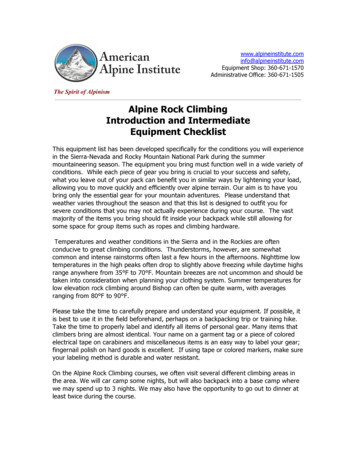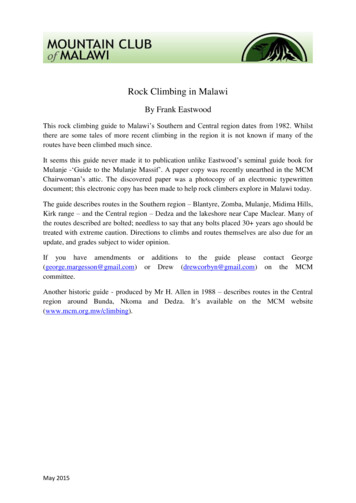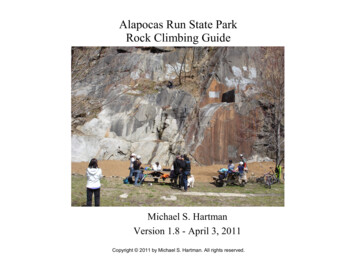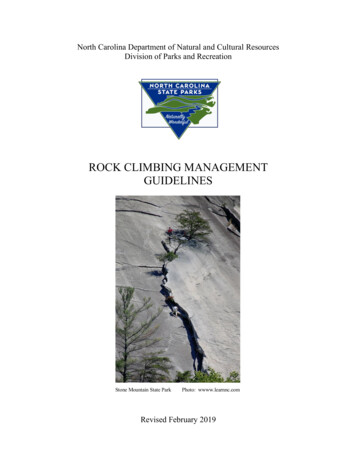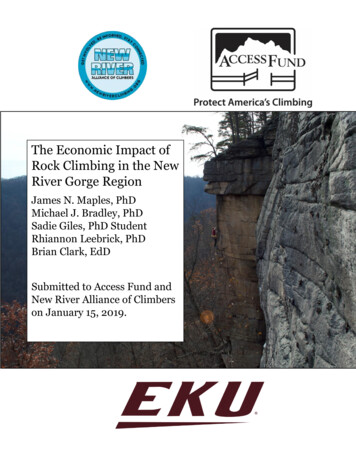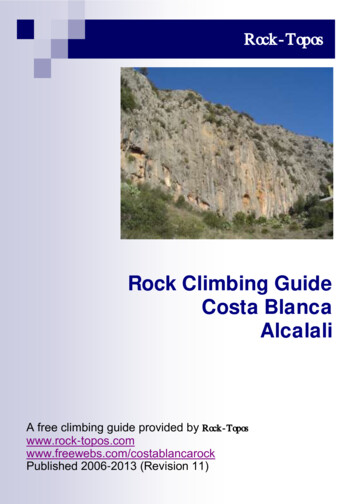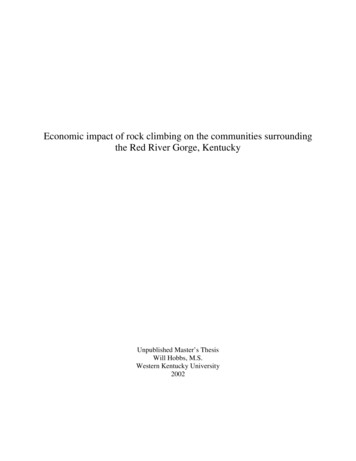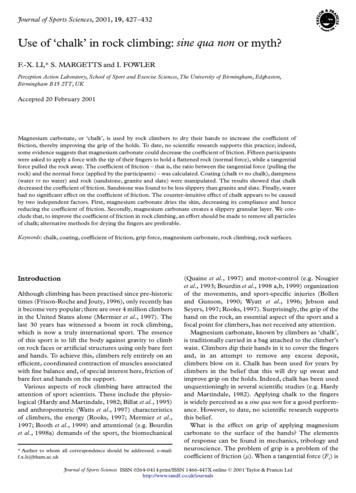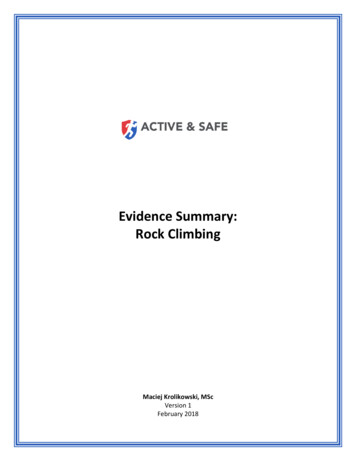
Transcription
Evidence Summary:Rock ClimbingMaciej Krolikowski, MScVersion 1February 2018
The British Columbia Injury Research and Prevention Unit (BCIRPU) was established by the Ministry ofHealth and the Minister’s Injury Prevention Advisory Committee in August 1997. BCIRPU is housed withinthe Evidence to Innovation research theme at BC Children’s Hospital (BCCH) and supported by theProvincial Health Services Authority (PHSA) and the University of British Columbia (UBC). BCIRPU’s visionis to be a leader in the production and transfer of injury prevention knowledge and the integration ofevidence-based injury prevention practices into the daily lives of those at risk, those who care for them,and those with a mandate for public health and safety in British Columbia.Author: Maciej KrolikowskiEditors: Sarah A Richmond, Amanda BlackReproduction, in its original form, is permitted for background use for private study, education instructionand research, provided appropriate credit is given to the BC Injury Research and Prevention Unit. Citationin editorial copy, for newsprint, radio and television is permitted. The material may not be reproduced forcommercial use or profit, promotion, resale, or publication in whole or in part without written permissionfrom the BC Injury Research and Prevention Unit.For any questions regarding this report, contact:BC Injury Research and Prevention UnitF508 – 4480 Oak StreetVancouver, BC V6H 3V4Email: bcinjury1@cw.bc.caPhone: (604) 875-3776Fax: (604) 875-3569Website: www.injuryresearch.bc.caSuggested Citation:Krolikowski M, Black A, Richmond SA, Babul S, Pike I. Evidence Summary: Rock Climbing. Active & SafeCentral. BC Injury Research and Prevention Unit: Vancouver, BC; 2018. Available at http://activesafe.ca/.
Evidence synthesis toolSPORT:Rock Climbing & BoulderingInjury Mechanisms:Repetitive overuse is reported as the primary mechanism of injury in youth rock climbers (42%), and falls were the mechanism of injury in77.5% of rock climbing related injuries treated in emergency rooms from 1990-2007 (Nelson & McKenzie, 2009; Woollings, McKay, Kang,Meeuwisse, & Emery, 2015). Finger injuries account for 33-52% of all injuries, and are the most common site of re-injury associated withnonimpact acute injury or chronic overuse. (G. & Johnson, 2016).Incidence/PrevalenceRisk ngerboardingFingerboards are equippedwith various grips and aredesigned to be grasped withthe feet not touching theground for high-intensitytraining. A 4-weekfingerboarding trainingregimen been found toincrease grip strength andendurance in highly advancedcompetitive boulderers in arandomized control study.Although this study did notmeasure injury incidence, gripstrength has been found to bea potential risk factor for injury(Medernach, Kleinöder, &Lötzerich, 2015; Wollings,McKay, & Emery, 2015)There were no studies foundexamining the implementation orevaluation of climbinginterventions.Sport climbing injuriespresented in emergencydepartments (1990-2007)showed fractures, sprains andstrains accounted for thelargest proportion of injuries(29.0% and 28.6%,respectively). Lower extremitieswere the most frequentlyinjured body part (46.3% of allinjuries), whereas upperextremities were injured in29.2% of cases. Falls were themechanism of injury in 77.5% ofrock climbing related injuries(Nelson & McKenzie, 2009).The prevalence of injuriesassociated with rock climbingvary between 10% and 81%irrespective of cause, between10% and 50% for impactinjuries, between 28% and 81%for nonimpact acute traumainjuries, and between 33% to44% for chronic overuse injuries(G. & Johnson, 2016).A systematic review found thatfemales were at higher risk ofsprains, and males were at ahigher risk of lacerations andfractures. (Woollings, McKay, &Emery, 2015).One study found no difference ininjury between sexes (Woollings,McKay, & Emery, 2015).AgeFive studies reported no injuryrisk associated with age. Someshow higher hand and fingerinjuries in older age groups, andone study found the risk of reinjury increased for youngerclimbers compared to older(Woollings, McKay, & Emery,2015).Years of Climbing ExperienceIn the systematic review byWoollings et al., 2015, threeTarget Group:All agesResources
Rock ClimbingIt is reported that the injuryrate for rock climbing rangesfrom 131-428 injuries/100participants and 4.2injuries/1000 hours (93% due to“overuse”) (Campbell et al.,2015).Indoor ClimbingThe injury incidence in indoorclimbing ranges from 0.01 to0.079 injuries/1000 hours(Campbell et al., 2015).BoulderingThe reported incidenceproportion over 1 year hasbeen estimated to be 137injuries/100 participants ingeneral climbing and 103 & 127injuries/100 participants inoutdoor and indoor bouldering,respectively (G. & Johnson,2016)Foot Pain:One study reported that91.1%of climbers reported footpain while climbing, with76.79% removing their shoesintermittently to relievediscomfort. Of the climbersstudied, 98% were found to bewearing excessively tightclimbing footwear (McHenry,Arnold, Wang, & Abboud,2015).studies were founddemonstrating no significantassociation with years ofclimbing experience and injury.Four studies found years ofexperience to be a significantrisk factor (higher injury rates forclimbers with over 5 years ofexperience, as well as higherinjury rates in climbers with over1- years of experience)(Woollings, McKay, & Emery,2015).Body Mass Index (BMI)Some studies have shown anassociation with the risk of injuryand re-injury, as well as anincreased odds of having tendon2injuries with a BMI 20/kg/m .Body weight on its own;however, was not found to be arisk factor. Further evidenceneeded in this area (Lion, van,Remillieux, Perrin, & Buatois,2016; Woollings, McKay, &Emery, 2015).Climbing VolumeTotal climbing time did not havea significant effect in higherrated studies. One study foundthat climbing volume per weekincreased risk of injury.(Woollings et al., 2015)Grip StrengthOne study found no relationship
between grip strength (at 90degrees of elbow flexion) andinjury, whereas another studyexamining grip strength at 90degrees of shoulder flexion witha straight elbow found a mild tomoderate correlation (p 0.05).(Woollings, McKay, & Emery,2015)Indoor vs Outdoor ClimbingA significantly higher risk offinger injuries have been foundin outdoor bouldering comparedto indoor bouldering, whereas ahigher risk of fall-related injurieshas been found in indoorbouldering compared to outdoorbouldering (Woollings, McKay, &Emery, 2015)Previous InjuryThe average probability ofsustaining an injury with areported history of injury isreported at 35.6% (95% CI:34.7% to 36.8%), with anassociated relative risk ofre0injury of 1.55 (95% CI: 1.34 to1.80). The average probability ofsustaining at least one repetitiveoveruse re-injury is reported as63% (95% CI: 49% to 77%) (Jones& Johnson, 2016).
Works Cited:Campbell, A. D., Davis, C.,Paterson, R., Cushing, T. A., Ng,P., Peterson, C. S., McIntosh, S.E. (2015). PreparticipationEvaluation for Climbing Sports.Wilderness & EnvironmentalMedicine, 26(4), S40–S46.Works Cited:Lion, A., van, der Z., Remillieux,S., Perrin, P. P., & Buatois, S.(2016). Risk factors of handclimbing-related injuries.Scandinavian Journal ofMedicine & Science in Sports,26(7), 739–744.Jones, G., & Johnson, M. I.(2016). A Critical Review of theIncidence and Risk Factors forFinger Injuries in Rock Climbing.Current Sports MedicineReports, 15(6), 400–409.McHenry, R. D., Arnold, G. P.,Wang, W., & Abboud, R. J.(2015). Footwear in rockclimbing: Current practice. Foot,25(3), 152–158.Woollings, K. Y., McKay, C. D., &Emery, C. A. (2015). Risk factorsfor injury in sport climbing andbouldering: a systematic reviewof the literature. British Journalof Sports Medicine, 49(17),1094–1099.Nelson, N. G., & McKenzie, L. B.(2009). Rock climbing injuriestreated in emergencydepartments in the U.S., 19902007. American Journal ofPreventive Medicine, 37(3),195–200.Works Cited:Medernach, J. P. J., Kleinöder,H., & Lötzerich, H. H. H. (2015).Fingerboard in CompetitiveBouldering. Journal of Strengthand Conditioning Research,29(8), 2286–2295.Woollings, K. Y., McKay, C. D.,& Emery, C. A. (2015). Riskfactors for injury in sportclimbing and bouldering: asystematic review of theliterature. British Journal ofSports Medicine, 49(17), 1094–1099.
Review of Sport Injury Burden, Risk Factors and PreventionRock Climbing/BoulderingIncidence and PrevalenceSport climbing injuries presented in emergency departments (1990-2007) showedfractures, sprains and strains accounted for the largest proportion of injuries (29.0% and 28.6%,respectively). Lower extremities were the most frequently injured body part (46.3% of allinjuries), whereas upper extremities were injured in 29.2% of cases. Falls were the mechanism ofinjury in 77.5% of rock climbing related injuries (Nelson & McKenzie, 2009).The prevalence of injuries associated with rock climbing vary between 10% and 81%irrespective of cause, between 10% and 50% for impact injuries, between 28% and 81% fornonimpact acute trauma injuries, and between 33% to 44% for chronic overuse injuries (G. &Johnson, 2016).It is reported that the injury rate for rock climbing ranges from 131-428 injuries/100participants and 4.2 injuries/1000 hours (93% due to “overuse”) (Campbell et al., 2015). Theinjury incidence in indoor climbing ranges from 0.01 to 0.079 injuries/1000 hours (Campbell etal., 2015). For bouldering, the reported incidence proportion over 1 year has been estimated tobe 137 injuries/100 participants in general climbing and 103 & 127 injuries/100 participants inoutdoor and indoor bouldering, respectively (G. & Johnson, 2016).One study reported that 91.1%of climbers reported foot pain while climbing, with 76.79%removing their shoes intermittently to relieve discomfort. Of the climbers studied, 98% werefound to be wearing excessively tight climbing footwear (McHenry, Arnold, Wang, & Abboud,2015).Risk and Protective FactorsSexA systematic review found that females were at higher risk of sprains, and males were ata higher risk of lacerations and fractures; (Woollings, McKay, & Emery, 2015), however anotherstudy found no difference in injury between sexes (Woollings, McKay, & Emery, 2015).AgeFive studies reported no injury risk associated with age. Some show higher hand andfinger injuries in older age groups, and one study found the risk of re-injury increased foryounger climbers compared to older (Woollings, McKay, & Emery, 2015).Years of Climbing ExperienceIn the systematic review by Woollings et al., 2015, three studies were founddemonstrating no significant association with years of climbing experience and injury. Fourstudies found years of experience to be a significant risk factor (higher injury rates for climbers
with over 5 years of experience, as well as higher injury rates in climbers with over 1- years ofexperience) (Woollings, McKay, & Emery, 2015).Body Mass Index (BMI)Some studies have shown an association with the risk of injury and re-injury, as well as anincreased odds of having tendon injuries with a BMI 20/kg/m 2. Body weight on its own;however, was not found to be a risk factor. Further evidence needed in this area (Lion, van,Remillieux, Perrin, & Buatois, 2016; Woollings, McKay, & Emery, 2015).Climbing VolumeTotal climbing time did not have a significant effect in higher rated studies. One studyfound that climbing volume per week increased risk of injury (Woollings et al., 2015).Grip StrengthOne study found no relationship between grip strength (at 90 degrees of elbow flexion)and injury, whereas another study examining grip strength at 90 degrees of shoulder flexion witha straight elbow found a mild to moderate correlation (p 0.05) (Woollings, McKay, & Emery,2015).Indoor vs Outdoor ClimbingA significantly higher risk of finger injuries have been found in outdoor boulderingcompared to indoor bouldering, whereas a higher risk of fall-related injuries has been found inindoor bouldering compared to outdoor bouldering (Woollings, McKay, & Emery, 2015)Previous InjuryThe average probability of sustaining an injury with a reported history of injury isreported at 35.6% (95% CI: 34.7% to 36.8%), with an associated relative risk of re-injury of 1.55(95% CI: 1.34 to 1.80). The average probability of sustaining at least one repetitive overuse reinjury is reported as 63% (95% CI: 49% to 77%) (Jones & Johnson, 2016).Opportunities for Prevention: Effective Interventions, Cost-Effectiveness,Implementation and EvaluationVery few evidence based injury preventions strategies have been evaluated in rockclimbing or bouldering. Stretching is often used as a prevention strategy; however, associationsbetween stretching and climbing-related injury are inconclusive. Wrist-taping and weigh traininghave been found to be associated with a decreased risk of injuries. (Woollings, McKay, & Emery,2015)Fingerboards are equipped with various grips and are designed to be grasped with thefeet not touching the ground for high-intensity training. A 4-week fingerboarding trainingregimen has been found to increase grip strength and endurance in highly advanced competitiveboulderers in a randomized control study. Although this study did not measure injury incidence,grip strength has been found to be a potential risk factor for injury (Medernach, Kleinöder, &Lötzerich, 2015; Wollings, McKay, & Emery, 2015)
ReferencesCampbell, A. D., Davis, C., Paterson, R., Cushing, T. A., Ng, P., Peterson, C. S., McIntosh, S. E.(2015). Preparticipation evaluation for climbing sports. Wilderness & EnvironmentalMedicine, 26(4), S40–S46. doi:10.1016/j.wem.2015.09.014Gaudio, F. G., Greenwald, P. W., & Holton, M. (2010). Injury and illness in college outdooreducation. Wilderness and Environmental Medicine, 21(4), 363–370.doi:10.1016/j.wem.2010.08.001Jones, G., & Johnson, M. I. (2016). A critical review of the incidence and risk factors for fingerinjuries in rock climbing. Current Sports Medicine Reports, 15(6), n, G., Shinneman, S., Tamayo-sarver, J., Josephsen, K., Boulware, D., Hunt, M., & Pham,H. (2007). Injuries in bouldering : A prospective study. Wilderness and EnvironmentalMedicine, 18(4), 271–280. doi:10.1580/06-WEME-OR-071R1.1Lack, D. A., Sheets, A. L., Entin, J. M., & Christenson, D. C. (2012). Rock climbing rescues: Causes,injuries, and trends in boulder county, Colorado. Wilderness and Environmental Medicine,23(3), 223–230. doi:10.1016/j.wem.2012.04.002Lion, A., van, der Z., Remillieux, S., Perrin, P. P., & Buatois, S. (2016). Risk factors of handclimbing-related injuries. Scandinavian Journal of Medicine & Science in Sports, 26(7), 739–744. doi:10.1111/sms.12505McHenry, R. D., Arnold, G. P., Wang, W., & Abboud, R. J. (2015). Footwear in rock climbing:Current practice. Foot, 25(3), 152–158. doi:10.1016/j.foot.2015.07.007Medernach, J. P. J., Kleinöder, H., & Lötzerich, H. H. H. (2015). Fingerboard in competitivebouldering. Journal of Strength and Conditioning Research, 29(8), , N. G., & McKenzie, L. B. (2009). Rock climbing injuries treated in emergency departmentsin the U.S., 1990-2007. American Journal of Preventive Medicine, 37(3), x, L., Quaine, F., Labarre-Vila, A., & Moutet, F. (2006). Estimation of finger muscletendon tensions and pulley forces during specific sport-climbing grip techniques. Journal ofBiomechanics, 39(14), 2583–2592. doi:10.1016/j.jbiomech.2005.08.027Vigouroux, L., Quaine, F., Paclet, F., Colloud, F., & Moutet, F. (2008). Middle and ring fingers aremore exposed to pulley rupture than index and little during sport-climbing: A biomechanicalexplanation. Clinical Biomechanics, 23(5), 562–570.
Woollings, K. Y., McKay, C. D., & Emery, C. A. (2015). Risk factors for injury in sport climbing andbouldering: A systematic review of the literature. British Journal of Sports Medicine, 49(17),1094–1099. doi:10.1136/bjsports-2014-094372Woollings, K. Y., McKay, C. D., Kang, J., Meeuwisse, W. H., & Emery, C. A. (2015). Incidence,mechanism and risk factors for injury in youth rock climbers. British Journal of SportsMedicine, 49(1), 44–50. doi:10.1136/bjsports-2014-094067
Evidence synthesis tool SPORT: Rock Climbing & Bouldering Target Group: All ages Injury Mechanisms: Repetitive overuse is reported as the primary mechanism of injury in youth rock climbers (42%), and falls were the mechanism of injury in 77.5% of rock climbing related injuries treated in emergency rooms from 19
